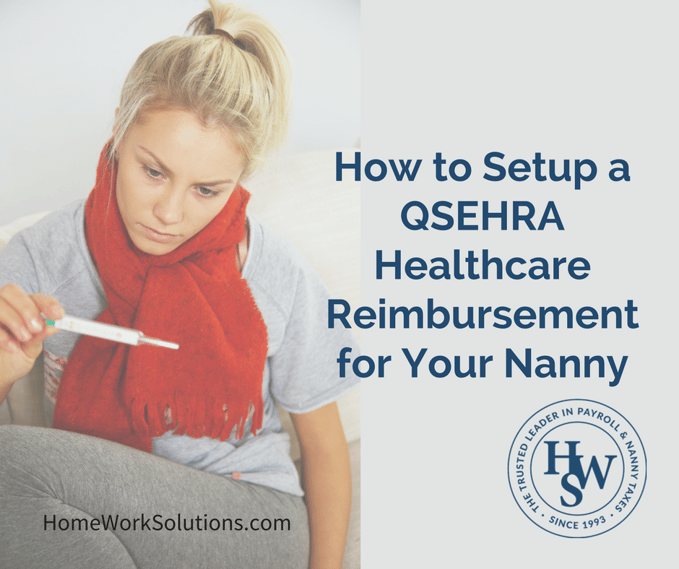
Update: 2020 reimbursement maximums are $5,250 ($437.50 monthly) for an individual and $10,600 ($883.33 monthly) for a family.
Update: 2019 reimbursement maximums are $5,150 ($429.16 monthly) for an individual and $10,450 ($870.83 monthly) for a family.
Update: 2018 reimbursement maximums are $5,050 ($420.83 monthly) for an individual and $10,200 ($850 monthly) for a family.
Helping your nanny, caregiver or other household employee pay for health insurance on a tax free basis was complicated by provisions of the Affordable Care Act in 2013. In December 2016 the 21st Century Cures Act was enacted, making it much easier for household employers as well as other small employers to provide tax free health benefits to household employees.
Beginning in 2017, you can institute a Qualified Small Employer Health Reimbursement Arrangement (QSEHRA) and start helping your nanny pay for her health insurance and other medical costs.
What the QSEHRA Plan Can Do
Starting in 2017, household employers may reimburse individually purchased health insurance (policies purchased by the nanny or caregiver in the individual exchange) and other deductible medical costs of up to $4,950 ($412.50 monthly) for an individual and up to $10,000 ($833 monthly) for a family. The amount must be prorated to reflect partial year coverage for employees who do not work a full year.
There are some steps the employer offering the QSEHRA must follow to be compliant. Please note these healthcare reimbursement plans are easier, not effortless!
Step 1. Notice of the Plan
Household employers must give their household employees written notice of the qualified small employer health reimbursement arrangement :
- Ninety days before the beginning of a plan year (for calendar years 2018 and later)
- In the case of an employee who is not eligible to participate in the arrangement as of the beginning of a plan year, the date on which such employee is first eligible (typically at 90 days of employment)
- 2017 Transition Relief: While the law states a deadline of March 12, 2017, for a 2017 calendar year plan, the IRS issued Notice 2017-20 which provides transition relief giving the IRS time to develop formal guidance to employers. As of June 14, 2017 this formal guidance is still being developed.
The written notice to the eligible employees needs to state:
- The amount of the QSEHRA benefit offered
- A statement that should the employee purchase coverage on a Health Insurance Exchange and applies for advance premium credits, the employee must inform the exchange of the QSEHRA coverage
- A statement that if the employee does not have other coverage that constitutes minimum essential coverage, the employee may be subject to penalties under the individual mandate provisions of the ACA, and the QSEHRA reimbursements might be included in the employee’s gross income
Step 2. Request for Reimbursement
The new law states that after the employee provides proof of minimum essential coverage, the employer may pay or reimburse the eligible employee for medical expenses defined in IRC Section 213(d) that were or are incurred by the eligible employee and, in the case of a family plan, his or her family members.
Your employee is required to provide you proof of health insurance coverage before becoming eligible to receive QSE-HRA funds. If the employee provides this evidence to the employer but later fails to retain the insurance coverage, benefits received after that coverage is lost may become taxable to the employee.
To protect yourself and meet the letter of the law, you should use a reimbursement form that requires the employee to provide proof of minimum essential coverage and attestation with respect to requests for any Section 213(d) reimbursements or payments on each request for reimbursement. You, the employer, must review receipts and other documents from your employee to verify medical expenses are eligible for reimbursement under the QSEHRA. Reimbursement forms are available for purchase on the internet; HWS regrets we cannot provide professional guidance on what expenses are eligible for reimbursement or proper forms for documentation of reimbursements.
Step 3. IRS Reporting
Procedural details here are still being worked out by the IRS. The law provides that he employer must report the QSEHRA amount available for reimbursement on each eligible employee’s Form W-2 and must report any taxable reimbursements made under the QSEHRA.
Because there are W-2 reporting requirements, clients must subscribe to a complete Household Employee Payroll Service and process reimbursements through the payroll process to insure compliance.
The QSEHRA Healthcare Reimbursement is Only for Small Employers
You are an “eligible employer” for the small business HRA if you
- are an employer with fewer than 50 full-time employees during the preceding year, and
- do not offer a group health plan to any of your employees.
You can Outsource QSEHRA and ICHRA Administration!
Many employers are reluctant to administer their HRA plans because of the intimate nature of the information the employee needs to share for reimbursement. Those looking for a comprehensive solution to QSEHRA administration should consider enrolling with our partners at Take Command Health. Their QSEHRA Guide and ICHRA Guide have detailed answers to all of your HRA related questions. Even better, if you enroll with promo code HOMEWORK30 you'll receive 30% off standard pricing.
Watch for Updates!
We are watching carefully for the IRS to publish formalized guidance on compliance issues for employers instituting a QSEHRA plan. Bookmark this post!
Related Links
Is Health Insurance for My Employee Taxable?
SAMPLE TEMPLATE: Household Employer QSEHRA Plan Document and Reimbursement Form
